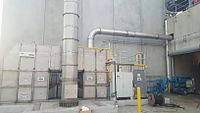
Photo from wikipedia
Abstract The principle of hybridizing a solid/gas thermochemical refrigeration cycle with a power cycle is extended to two novel hybrid cycles (called operating modes). They can be driven by low-grade… Click to show full abstract
Abstract The principle of hybridizing a solid/gas thermochemical refrigeration cycle with a power cycle is extended to two novel hybrid cycles (called operating modes). They can be driven by low-grade heat, and they allow storing this energy and converting it predominantly into mechanical power. For this purpose, they integrate an original autothermal power production during their discharging step, which is deeply analyzed. In addition, depending on the operating mode, power can be produced in both charging and discharging steps and an additional cold production can be provided. A deep thermodynamic study was carried out to assess the performance of these cycles, for 103 solid/gas pairs. These cycles allow converting low-grade heat sources from 87 °C to 250 °C. The maximal energy and exergy efficiencies for power and cold cogeneration are 0.24 and 0.40, respectively, and the maximal exergy density is 722 kJ/kgNH3. The part of power production reaches 62% (when it occurs only in discharging step) to 78% (when it occurs in both steps).
Journal Title: Applied Energy
Year Published: 2020
Link to full text (if available)
Share on Social Media: Sign Up to like & get
recommendations!